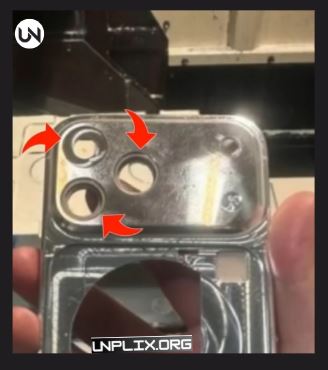A recent leak of the All-Aluminum Chassis for the upcoming iPhone 17 Pro has set the tech world abuzz. This isn’t just another design update — it represents a major material shift. Apple appears to be moving away from titanium and reintroducing aluminum into its premium lineup. The change points to a stronger focus on lightweight durability, improved thermal efficiency, and refined aesthetics.
This move suggests Apple sees aluminum not as a downgrade, but as the future of high-end devices, offering the perfect blend of strength, sustainability, and style.
Also Read: Vivo X300 Pro 5G India Launch 2025: Expected Price, Features, Specs & Release Date
The All-Aluminum Chassis: First Look
What the Leak Reveals
The leaked prototype of the iPhone 17 Pro shows a unibody aluminum design, where the frame and camera bump are carved from a single piece of metal. This results in a cleaner, seamless finish. A circular cutout on the back accommodates wireless charging and MagSafe, ensuring functionality is preserved despite the shift to metal.
Camera Module Design
The device features a bold, rectangular camera housing that stretches across the rear panel. Unlike earlier dual-tone designs, the new camera module appears to be color-matched to the body, creating a unified look.
A Return to Aluminum in Pro Models
This marks the first time Apple has used aluminum in its flagship Pro lineup since splitting the iPhone range into “Pro” and “standard” tiers. While entry-level models like the iPhone SE and iPhone 16 continued using aluminum, Pro versions relied on stainless steel, then titanium. Now, Apple is once again embracing all-aluminum chassis engineering for its premium devices.
Aluminum vs Titanium: Why the Shift is Significant
Apple previously marketed titanium as a cutting-edge material for durability and exclusivity. However, aluminum offers distinct advantages that align with modern user expectations:
- Lightweight Build: Up to 40% lighter than titanium, making large-screen devices easier to handle.
- Better Heat Management: Aluminum disperses heat efficiently, reducing overheating during heavy gaming or multitasking.
- Cost-Effective: Easier to source and manufacture, potentially lowering production costs without compromising quality.
- Eco-Friendly: Aluminum is highly recyclable, supporting Apple’s sustainability goals.
- Versatile Finishes: Its surface allows for anodizing, enabling sleek, vibrant, and durable color options.
Design Implications: Form Meets Function
- Integrated Camera Bump – Built from the same aluminum frame for a polished, cohesive look.
- Improved Thermal Control – Works hand-in-hand with advanced cooling systems for consistent performance.
- Durability Boost – Resistant to cracking and stronger than glass-backed alternatives.
- Seamless Wireless Charging – A glass insert ensures full MagSafe compatibility without interference.
Benefits of an All-Aluminum Chassis
- Lightweight Handling – Makes larger phones easier to hold and carry.
- Superior Heat Dissipation – Keeps devices cooler during extended use.
- Strength and Durability – Provides a robust frame with fewer weak points.
- Streamlined Aesthetics – Creates a clean, elegant, and unified body.
- Eco-Friendly Advantage – Highly recyclable, reducing environmental impact.
- Enhanced Customization – Supports a wide range of anodized finishes and colors.
Frequently Asked Questions (FAQs) About the All-Aluminum Chassis
1. What does “all-aluminum chassis” mean for the iPhone 17 Pro?
It means the body is built from a single block of aluminum, with the frame and camera housing seamlessly integrated.
2. Why is Apple switching from titanium to aluminum?
Aluminum is lighter, offers better thermal conductivity, and supports Apple’s long-term sustainability goals.
3. Will aluminum affect wireless charging?
No. A dedicated glass cutout ensures MagSafe and wireless charging remain fully functional.
4. Is aluminum more durable than glass?
Yes. Aluminum is less likely to shatter compared to glass, though it can still show scratches or dents.
5. Does aluminum feel as premium as titanium?
While titanium has a denser feel, aluminum balances premium aesthetics with practical benefits.
6. Will the iPhone 17 Pro still support MagSafe?
Yes. The chassis is designed with MagSafe compatibility in mind.
7. How does aluminum improve thermal performance?
It spreads heat more evenly, helping the phone stay cool under heavy workloads.
8. Will this chassis allow new colors?
Most likely. Aluminum supports anodized finishes, enabling fresh and more durable color options.
9. Is aluminum more eco-friendly than titanium?
Yes. It is easier to recycle and more widely available, making it a greener choice.
10. When will the iPhone 17 series launch?
Apple typically unveils new iPhones in early September, with sales starting shortly after.
Conclusion & Key Takeaways
The All-Aluminum Chassis Leak of the iPhone 17 Pro reveals much more than a material shift. It highlights Apple’s renewed commitment to innovation that balances style, performance, and sustainability. By choosing aluminum, Apple may be redefining what consumers expect from a premium smartphone: lightweight durability, superior thermal control, and refined design.
Key Takeaways
- Unibody Construction: Integrated frame and camera bump for a sleek design.
- Lightweight & Strong: Easier to carry while maintaining strength.
- Thermal Efficiency: Better heat management ensures stable performance.
- Wireless Charging Ready: Smart design keeps MagSafe fully functional.
- Eco-Conscious Design: Aluminum aligns with modern sustainability efforts.
The all-aluminum chassis isn’t just a design change — it’s a forward-looking step that could set the new standard for premium smartphones.




